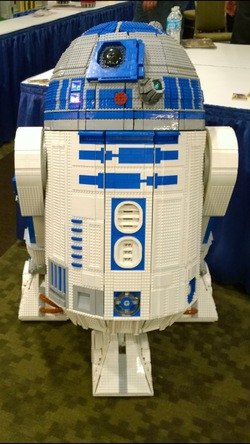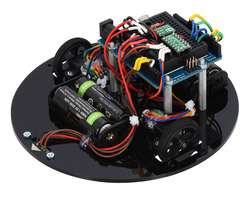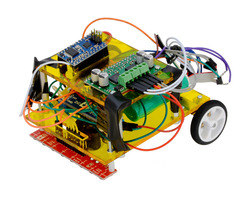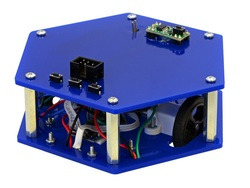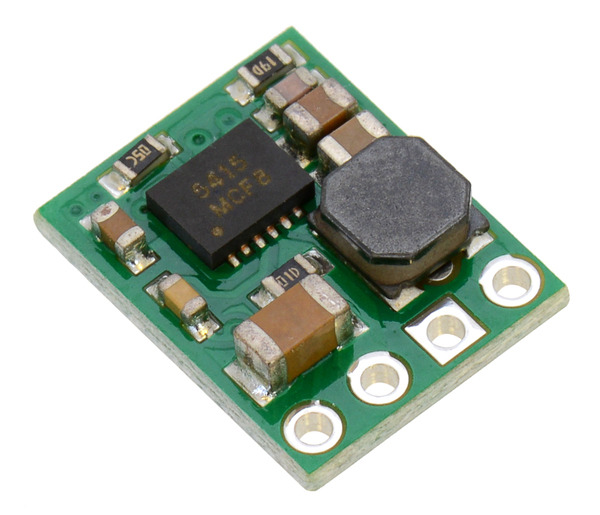Pololu Blog »
Pololu Blog (Page 66)
Welcome to the Pololu Blog, where we provide updates about what we and our customers are doing and thinking about. This blog used to be Pololu president Jan Malášek’s Engage Your Brain blog; you can view just those posts here.
Popular tags: community projects new products raspberry pi arduino more…
L3-G0: the full-size, LEGO R2-D2
Shawn and Lara Steele, known on the Pololu forum as kresty, built a functional, full-size, LEGO R2-D2 named L3-G0. L3-G0’s design is based on plans from the R2-D2 Builder’s Club, and it is made from around 16,000 LEGO bricks. It weighs roughly 30 kg (65 lbs) and can travel at a speed of 8 km/h (5 mph). The astromech has a fully functional rotating dome with multiple blinking lights. The dome is rotated using our 80mm wheel fitted with a high-traction sticky tire and powered by one of our 37D gearmotors. L3-G0 is controlled using a 9-channel RC transmitter and features an Arduino along with dedicated motor controllers and sound boards. Electric scooter motors were used for the drive wheels. The astromech also uses Pololu motor controllers and voltage regulators, as well as a SparkFun MP3 Trigger for audio. Continued…
New product: A-Star 32U4 Micro
Today we released a general-purpose AVR microcontroller breakout board, the A-Star 32U4 Micro. But before I get to the A-Star (A* for short), I would like to mention some of our history with AVR boards.
Some of our history with AVR boards
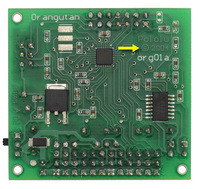 |
Original Orangutan Robot Controller (back view) from 2004. |
|---|
It has been almost ten years since we introduced our Orangutan Robot Controller, which featured an AVR microcontroller, dual motor drivers, and user-friendly features like a display and buzzer. Over the years we expanded the line, making larger, more complicated Orangutans like the Orangutan SVP as well as the miniature Baby Orangutan.
I have used the Baby Orangutan in many of my own projects, because I like its simplicity and small size. Ironically, the built-in motor driver gets in the way when I want to use a newer motor driver such as the DRV8835 in a project, since valuable PWM pins are unavailable. So I have built my more recent robots using minimal microcontroller breakout boards without motor drivers, such as Arduinos and the Wixel. (I posted about my latest such project last week.)
Our focus has been on boards that include motor drivers, and we have not had a really simple microcontroller board for people who don’t want the motor driver. Even though there are far more powerful controllers available, 8-bit AVR microcontrollers continue to be popular in the community, and the basic AVR breakout board is something we have wanted to make for a long time.
 |
Original ATmega168-based Baby Orangutan robot controller from 2005 (left) next to A-Star 32U4 Micro boards. |
|---|
Introducing the A-Star 32U4 Micro
That is why I am excited today to announce the A-Star 32U4 Micro, a Pololu breakout board for Atmel’s ATmega32U4 AVR microcontroller:
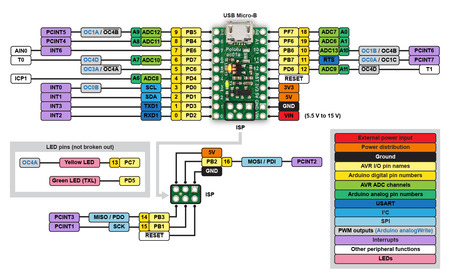 |
A-Star 32U4 Micro pinout diagram. |
|---|
Compared to the popular ATmega328P microcontroller that we used on several Orangutan models, the ATmega32U4 is a newer processor with features like more analog inputs, more PWM outputs, and, most importantly, USB support. The USB connection, which we have broken out to a Micro-B connector, makes programming easy and enables interesting projects involving connections to a PC.
Also, since the ATmega32U4 is used on the Arduino Leonardo, Arduino Micro, and many other breakout boards, there is a large community with experience using the microcontroller. To support this community, we are shipping the A* with an Arduino-compatible bootloader and have followed Arduino conventions including pin numbering and LED connections.
Since we wanted to make a minimal breakout board, we decided to make it as small as we could, hoping that it would be small and cheap enough to go into (and stay in) almost any project. The result is that the A-Star 32U4 Micro is, as far as we know, the smallest ATmega32U4 breakout board available. It is even smaller than some AVR boards with less powerful microcontrollers that implement USB support in software and have only a few general-purpose I/O lines available.
 |
The Pololu A-Star 32U4 Micro is about half the size of an Arduino Micro. |
|---|
Now that we have reached a reasonable extreme on the minimal end, we intend to expand back toward more integrated features, eventually replacing our older Orangutan robot controllers with versions offering more modern power handling and perhaps other features like inertial measurement sensors. What would you like to see in an integrated robotics or automation controller? Did we leave out too much on the A-Star 32U4 Micro? Please let us know in the comment section.
For more information, see the A-Star 32U4 Micro product page.
Pololu at the Las Vegas Mini Maker Faire 2014
Last weekend Las Vegas had its second Mini Maker Faire. The event was hosted by the local hacker space Syn Shop and included booths with displays ranging from 3D printers, electric cars, and a full-size R2-D2 to art exhibits and handmade steampunk clothing. Pololu had a booth at the event with several demos of products like our Simple Motor Controllers, linear actuators, LED strips, and Zumo Robots. We will be following up this post later with others that detail some of the specific demos, but in the meantime, check out this video of the event!
Jon's dead reckoning robot
Like other engineers here, I made a robot for the LVBots dead reckoning competition. Before I knew about this competition, I hadn’t made a successful dead reckoning robot. By the end of this competition, I still hadn’t made a successful dead reckoning robot. However, I did learn more about myself and a little more about line following. This post describes my robot, Usain Volt, and details some of what I was thinking when I designed it. Continued…
New product: 130-size, high-power brushed DC motor
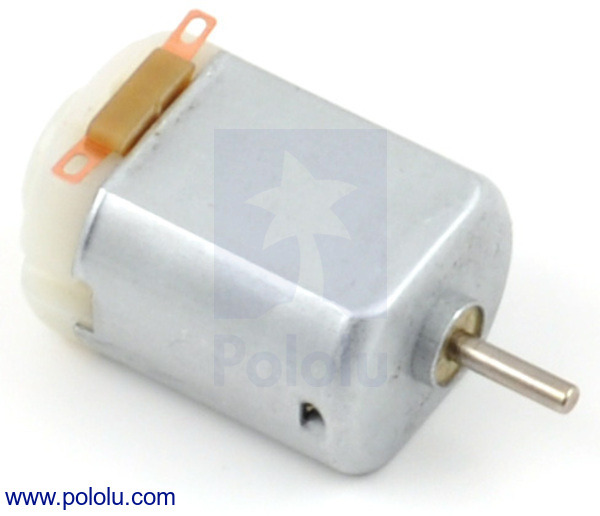 |
These new 130-size motors are great for applications that require a lot of power in a small package. They are a generic alternative the Solarbotics RM2 motors, which have the same form factor and nearly identical performance. With a free-run speed of 17,000 RPM at 3 V, they are great for upgrading projects driven by lower-power 130-size motors. For example, see this post from last year about upgrading flywheel NERF guns. This motor is also compatible with our larger Pololu plastic gearmotors (228:1 offset, 120:1 offset, 200:1 90-degree, and 120:1 90-degree) and Solarbotics plastic gearmotors (GM2, GM3, GM8, and GM9).
For more information see the Brushed DC Motor: 130-Size, 3V, 17kRPM, 3.6A Stall product page.
Paul's dead reckoning robot
This post is about my first-place entry in the 2014 LVBots Dead Reckoning Competition, a 150 mm round robot named paul-dead-reckoning2.88ec5df. I designed this robot to be similar to the 3pi, but larger, to leave plenty of room for wiring and sensor mounting. The central controller is an Arduino Leonardo, and (unlike the 3pi), the motors are equipped with quadrature encoders. Continued…
Claire's dead reckoning robot
Like several of the other engineers here at Pololu, I made a robot to compete in the LVBots Dead Reckoning Competition that took place recently. This post describes my robot, Tryangle, and the decisions that went into making it. For more information about what dead reckoning is and how it is judged, see the LVBots dead reckoning rules. Continued…
R2-DR, Kevin's dead reckoning robot
When I first started planning a robot for the recent LVBots dead reckoning competition, it was more or less a conventional design—a flat chassis with motors and circuit boards attached to the top and bottom—and I lost interest in it quickly because it felt like I was just reinventing the 3pi. I looked for a way to make the shape of the robot unique, and I noticed that the three-legged shape of R2-D2, the famous astromech droid from Star Wars, might be a good fit for a typical undercarriage composed of a ball caster and two wheels. The result of continuing along this line of investigation is my dead reckoning robot, R2-DR (you can probably guess what DR stands for). Continued…
Brandon's dead reckoning robot
For the recent LVBots dead reckoning competition that was hosted here at Pololu, I decided to make a robot based on the Baby Orangutan robot controller. This post details my robot and some of the considerations made while I went through my design process. If you would like more details about the competition rules and how it was judged, see the LVBots dead reckoning rules (23k pdf).
I started by choosing my parts and making sure that my robot, which would later be named “Baby Blues”, would be able to function in the way I wanted. I decided on using the Baby Orangutan because of its integrated motor driver and compact size. Continued…
New products: 500mA Step-Down Voltage Regulator D24V5Fx
We are happy to introduce our D24V5Fx voltage regulator family, a next-generation version of our tiny D24V3Fx and D24V6Fx buck (step-down) regulators, which have been some of our most popular products. These new regulators are synchronous, which results in better efficiency, especially at light loads, and they have much lower dropout voltages (e.g. the 5 V version has just over 1 mV of dropout per mA of output current).
So far we have versions with 3.3 V, 5 V, 9 V, and 12 V outputs, and we will soon be releasing 1.8 V, 2.5 V, and 6 V versions; you can contact us for custom voltages, too. They operate with input voltages up to 36 V and have typical efficiencies of 80% to 93%. These regulators have integrated over-temperature and over-current shutoff, and they reduce their switching frequency from the typical 500 kHz to improve efficiency at light loads, making them well suited for low-power applications that are run from a battery.
At only 0.5″ × 0.4″ × 0.1″ (13 mm × 10 mm × 3 mm) these buck regulators are also smaller than standard through hole linear regulators with DIP packages. The picture below shows a D24V5Fx next to a 7805 voltage regulator in a TO-220 package.
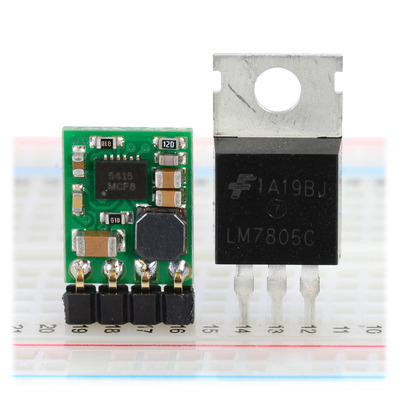 |
For other regulator options, you can take a look at our full selection of step-up voltage regulators, step-down voltage regulators, and step-up/step-down voltage regulators.
